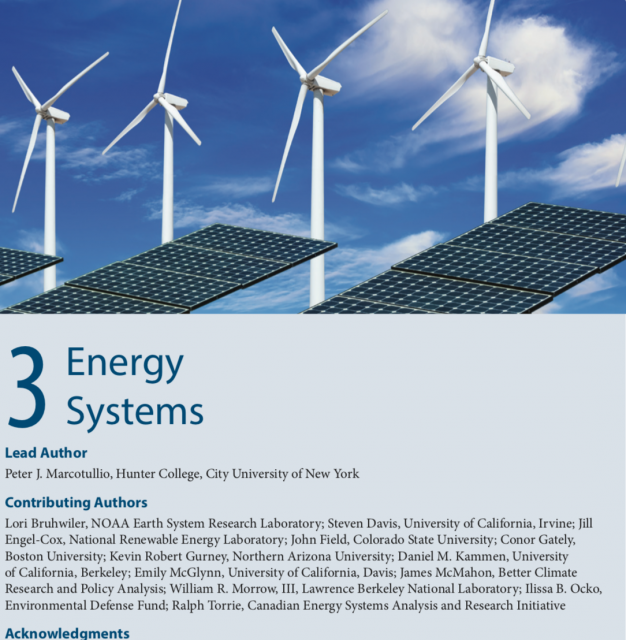KEY FINDINGS
- In 2013, primary energy use in North America exceeded 125 exajoules,1 of which Canada was respon- sible for 11.9%, Mexico 6.5%, and the United States 81.6%. Of total primary energy sources, approxi- mately 81% was from fossil fuels, which contributed to carbon dioxide equivalent (CO2e)2 emissions lev- els, exceeding 1.76 petagrams of carbon, or about 20% of the global total for energy-related activities. Of these emissions, coal accounted for 28%, oil 44%, and natural gas 28% (very high confidence, likely).
- North American energy-related CO2e emissions have declined at an average rate of about 1% per year, or about 19.4 teragrams CO2e, from 2003 to 2014 (very high confidence).
- The shifts in North American energy use and CO2e emissions have been driven by factors such
as 1) lower energy use, initially as a response to the global financial crisis of 2007 to 2008 (high confidence, very likely); but increasingly due to 2) greater energy efficiency, which has reduced
the regional energy intensity of economic production by about 1.5% annually from 2004 to 2013, enabling economic growth while lowering energy CO2e emissions. Energy intensity has fallen annu- ally by 1.6% in the United States and 1.5% in Canada (very high confidence, very likely). Further factors driving lower carbon intensities include 3) increased renewable energy production (up 220 peta- joules annually from 2004 to 2013, translating to an 11% annual average increase in renewables) (high confidence, very likely); 4) a shift to natural gas from coal sources for industrial and electricity production (high confidence, likely); and 5) a wide range of new technologies, including, for example, alternative fuel vehicles (high confidence, likely). - A wide range of plausible futures exists for the North American energy system in regard to carbon emissions. Forecasts to 2040, based on current policies and technologies, suggest a range of carbon emissions levels from an increase of over 10% to a decrease of over 14% (from 2015 carbon emissions levels). Exploratory and backcasting approaches suggest that the North American energy system emissions will not decrease by more than 13% (compared with 2015 levels) without both technological advances and changes in policy. For the United States, however, decreases in emissions could plausibly meet a national contribution to a global pathway consistent with a target of warming to 2°C at a cumu- lative cost of $1 trillion to $4 trillion (US$ 2005).
Note: Confidence levels are provided as appropriate for quantitative, but not qualitative, Key Findings and statements.
1 One exajoule is equal to one quintillion (1018) joules, a derived unit of energy in the International System of Units.
2 Carbon dioxide equivalent (CO2e): Amount of CO2 that would produce the same effect on the radiative balance of Earth’s climate system as another greenhouse gas, such as methane (CH4) or nitrous oxide (N2O), on a 100-year timescale. For comparison to units of carbon, each kg CO2e is equivalent to 0.273 kg C (0.273 = 1/3.67). See Box P.2, p. 12, in the Preface for more details.
Recommended Citation for Chapter
Marcotullio, P. J., L. Bruhwiler, S. Davis, J. Engel-Cox, J. Field, C. Gately, K. R. Gurney, D. M. Kammen,
E. McGlynn, J. McMahon, W. R. Morrow, III, I. B. Ocko, and R. Torrie, 2018: Chapter 3: Energy systems. InSecond State of the Carbon Cycle Report (SOCCR2): A Sustained Assessment Report [Cavallaro, N., G. Shrestha, R. Birdsey, M. A. Mayes, R. G. Najjar, S. C. Reed, P. Romero-Lankao, and Z. Zhu (eds.)]. U.S. Global Change Research Program, Washington, DC, USA, pp. 110–188, https://doi.org/10.7930/SOCCR2.2018.Ch3.
